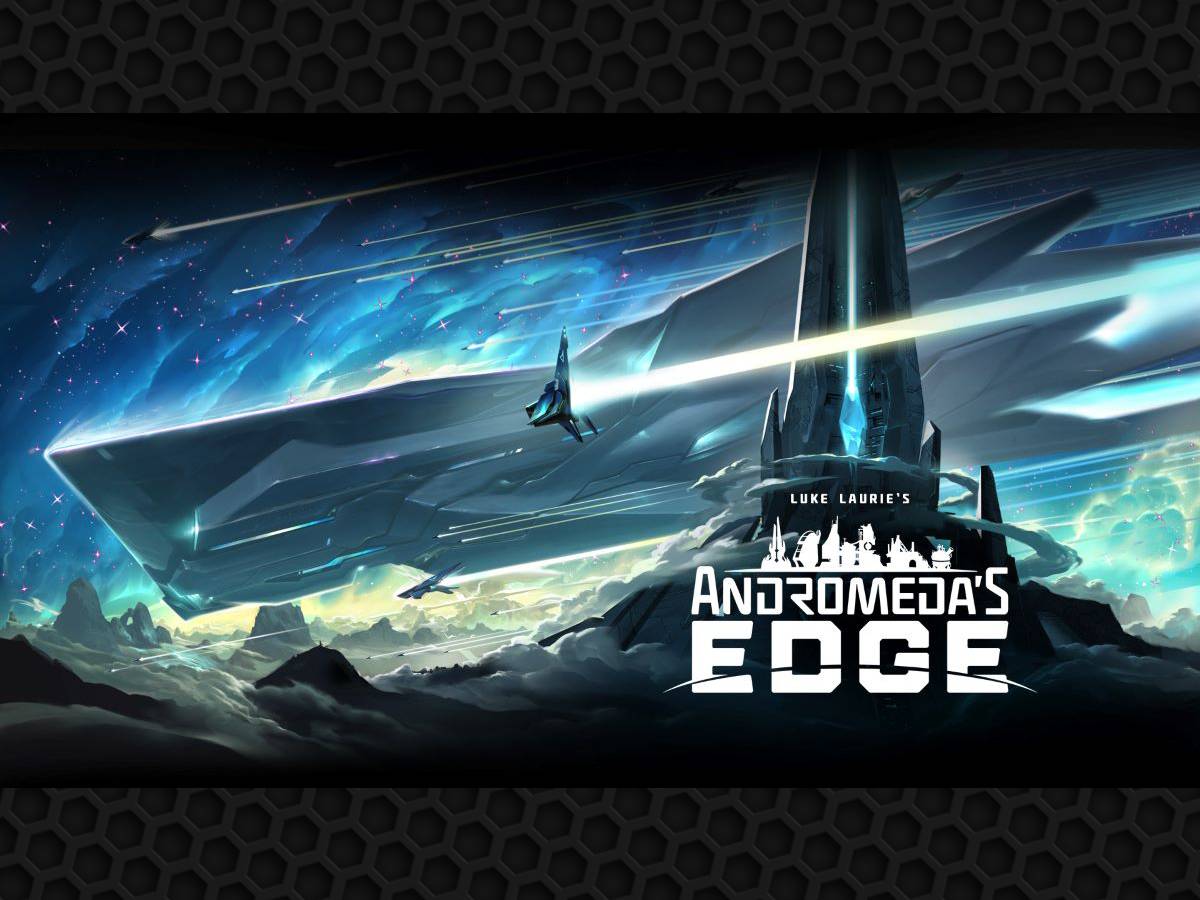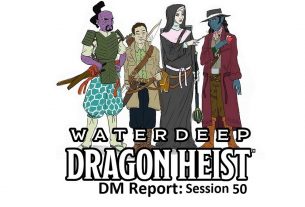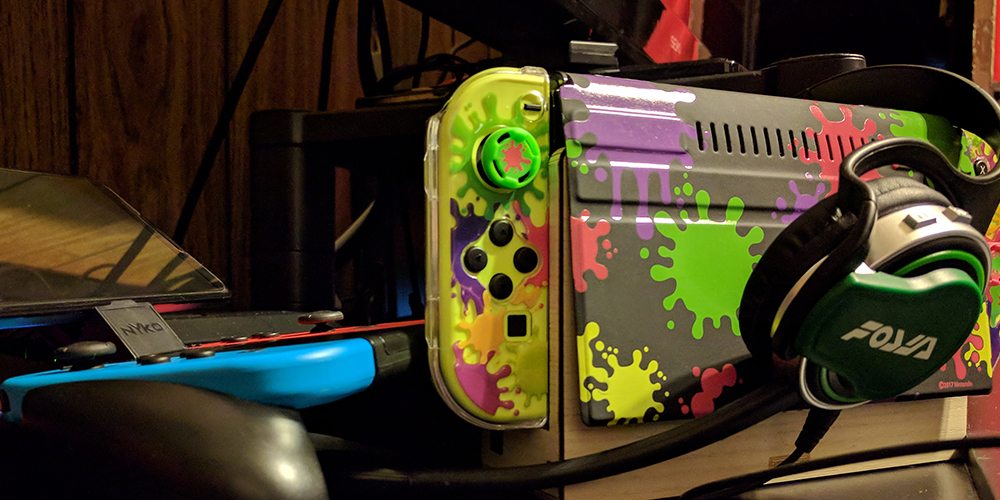Your people have fled the tyrannical control of UNITY, escaping to the Andromeda galaxy. Using the debris of a precursor civilization, and under constant threat from both raiders and other settlers, it’s up to you to build a new home on the frontier.
What Is Andromeda’s Edge?
Andromeda’s Edge is a game of worker placement and engine building for 1-5 players, ages 14 and up, and takes about 40 minutes to play per player. There’s a high level of strategy in the game, so it’s best suited for teens and adults. It’s currently seeking funding on Gamefound, with a pledge level of $69 for a standard edition of the game, $129 for a deluxe edition, and $189 for an all-in pledge. All versions include all unlocked stretch goals and a free copy of the Escalation expansion.
Andromeda’s Edge was designed by Luke Laurie and his son Maximus Laurie, and published by Cardboard Alchemy, with illustrations and model designs by Sergio Chaves.
New to Gamefound? Check out our crowdfunding primer.
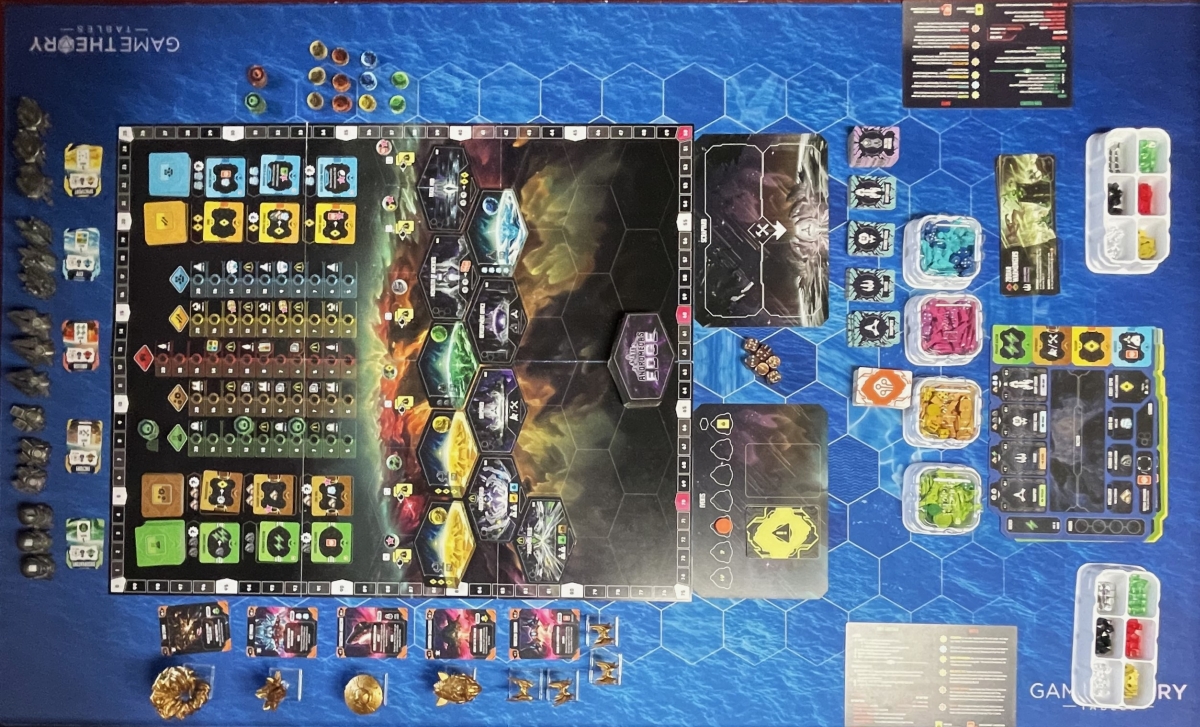
Andromeda’s Edge Components
Note: My review is based on a prototype copy, so it is subject to change and may not reflect final component quality. I already know for a fact that there have been changes made recently in the designs of the player and event boards, and the tactics cards. There will also be both a regular and deluxe version of the game, with different components in each version as you can see on the Gamefound campaign page.
Here are images of the components from the standard and deluxe versions of the game. First, the standard edition:

And here’s the deluxe edition:

The prototype game I received contains the following components:
- Main Board
- 4 Station Mats
- 4 Player Aids
- Event and Scrapyard Boards
- 16 Upgrade Tiles
- 8 Faction Upgrade Tiles
- 92 Modules
- 10 Event Cards
- 8 Faction Boards
- 15 Planet Regions
- 6 Alliance Base Regions
- 57 Tactics Cards
- 45 Moons
- 6 Nebula Moons
- 21 Discovery Tokens
- 8 Supremacy Tokens
- 15 Development Cards
- 15 Developments
- 5 Raider Cards
- 8 Raider Stands
- 8 Raiders
- 24 Track/Score Markers
- 36 Player Starships
- 36 Leaders
- 30 Dice
- 20 Nanocarbon Tokens
- 20 Credits Tokens
- 20 Ice Tokens
- 40 Energy Tokens
- 20 Titanium Tokens
- 40 Damage Tokens
- Event Tracker Token

The graphical design of the main board is subject to change, but the areas should stay largely the same. Running around the edge of the board is a score track. The numbers with a magenta background are the three different endgame score triggers that you choose between at the start of your game. At the bottom of the main board is a hex grid where you will build out the planets and Alliance bases. The very top row of that grid is the nebula, which can only be entered by certain ships. At the top of the board are the four different Modules: Science, Industry, Commerce, and Civilization. There are also four matching tracks for players to progress upon, as well as a fifth track, Supremacy, which is increased primarily by winning combats.

There are two additional boards for use by all players, the Event board and the Scrapyard board. The Event board has room for both the Event deck and discard pile. Additionally, there’s a progress track to proceed on towards an event. Meanwhile, the Scrapyard board has a space for ships destroyed in battle, and then another area for ships that have been repaired, known as the Repair Barge.

Each player gets an identical Station mat in their player color. These hold the player’s faction card, resources, moons, and ships. There is also the first Module for each of the Module rows.

There are eight asymmetric factions to choose from. Each provides an early start on two of the progress tracks, as well as a unique thematic ship upgrade and two play powers. A ninth faction, which is a race of space dragons, was available for free to followers of the campaign on Gamefound.
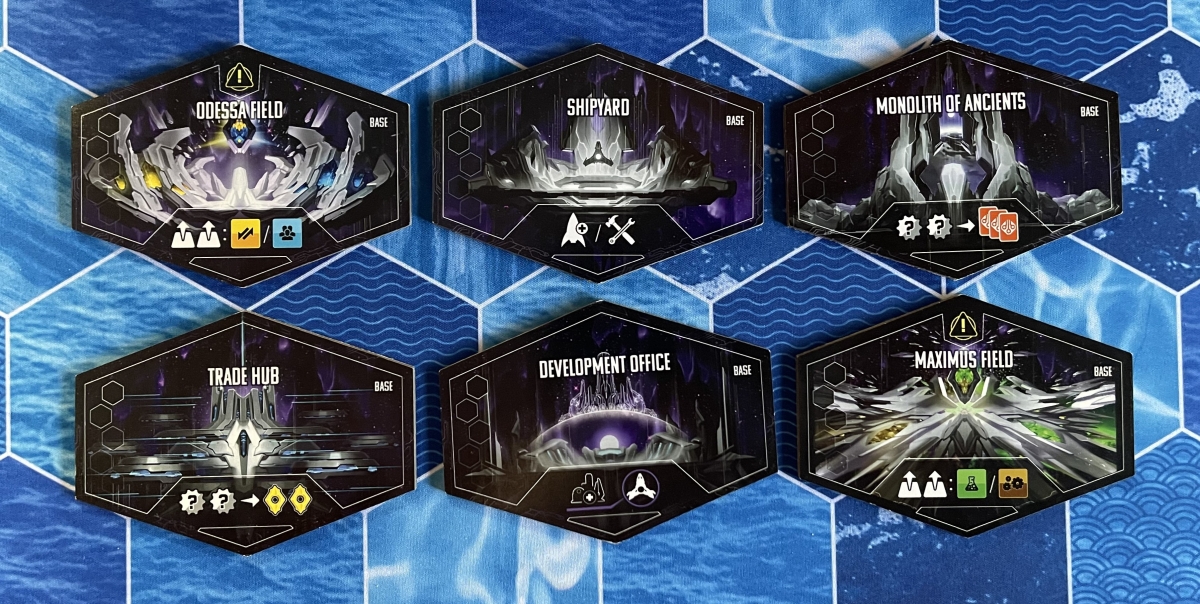
A game starts with the six Alliance Bases randomly placed on the board, along with a number of Planets based on the player count. The Alliance Bases allow you to take various actions depending on the base, as well as retrieve some of your leaders, which are a required component to developing planets.

Throughout the game, players will land ships on Planet Regions. These planets have moons which may be gathered and turned in for resources and effects, or slotted into Modules to generate resources. Additionally, planets are where players will build Developments, a major source of victory points in the game.

There are five different types of Developments that you can build. Each one is tied in to a different one of the tracks. A planet will indicate what specific development can be built there, as well as the resource cost.

During the course of the game, players can purchase and upgrade various Starships. These ships can be used for taking actions, building developments, and for fighting space battles. At the start of the game, players only have access to transports.
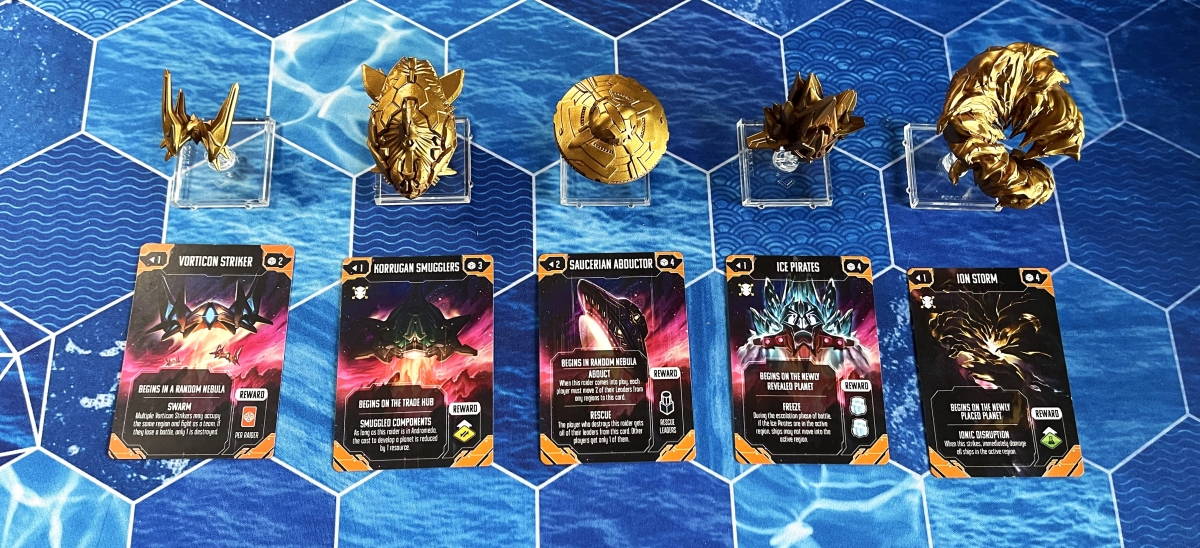
Whenever an Event card is played, a different type of Raider will appear somewhere on the map. They all provide various rewards for their destruction, and have different abilities. The final version of the game will have multiple Event and Raider decks, to provide more variety from game to game.
How to Play Andromeda’s Edge
You can read the rulebook here.
The Goal
The goal of Andromeda’s Edge is to develop planets, gain resources, and end the game with the most victory points.

Setup
General Setup
Start by choosing the Event deck and corresponding Raiders that will be used for the game. Then choose whether the game will end when someone reaches 50 victory points, 60 victory points, or 70 victory points.
Separate the Planetary Region tiles from the Alliance Base tiles. Shuffle the planets, and draw a number of them based on the player count. Shuffle those planets together with the bases, and then place them from left to right, starting on the row just below the nebula. Place the rest of the planets in a face-down draw pile at the bottom of the Main Board.
Shuffle each module deck and place them on their respective spaces. Draw the first 3 module cards of each deck and place them in the designated spaces below the decks.

Shuffle the Moon tokens of each color type and make them into stacks of 3. Place a stack of the matching color face up on each of the planets on the board. Place 1 Nebula moon face up on each Nebula region.
Shuffle the Discovery tokens and place stacks of 5 face down on the 2 spaces on the Science track. Place another stack of 5 face down on the Observatory Discoveries space on the Main board. Shuffle the Supremacy tokens and put 1 each face up on the 3 spaces of the Supremacy track.
Take 2 S-Class Raiders and roll 2 dice to place them on randomly determined Nebula hexes. Both Raiders may share the same space.
Put the Event marker on the space on the Event track matching the player count. Shuffle the Event deck and place it on its space. Stack the Development cards beside the Main board, alongside the matching Developments.
Player Setup

Each player chooses a player color, and receives a matching Station Mat, Starships, Leaders, Track Markers, and dice. Players place 3 of the Transport Starships on their Station Mat.
Players are dealt 2 random factions. Choose one, gaining the resources on the back, then place the Faction Card face up on the Station Mat. Each player then takes their unique faction Starship Upgrade and sets it beside their Station. Shuffle the neutral Starship Upgrades, and deal 1 of each type to each player. Place these beside the Station Mat, as you will not start with any upgrades.
Place the Track Markers on the first space of each track, and then advance 1 on each track as indicated for the track bonuses on the Faction Card.
Each player places 1 Leader on each Alliance Base, then rolls two dice and places Leaders in those Nebula Regions. 1 Leader is placed on the Station Mat.

Shuffle the Tactics cards and deal 3 to each player. Then place the deck near the Main Board.
All players roll all 6 of their dice, and compare results. The player with the highest value die left after ties are discarded is the first player. Each player places the Victory Point marker on the Victory Point track, on the number matching their player number.
Gameplay
Turn Sequence Steps
Launch Turn Step 1: Launch
Note: Only Starship with the Voyage keyword can travel into the Nebula regions.
If a player has no Starships in Andromeda, then they will be making a First Launch. First launches must be to a region without any Starships in it, if possible. You may only launch to a region in which you can perform the action in step 2.
Launch Turn Step 2: Action
Where you launch to will determine what action you can take:
- Planets. Take the top Moon token from the planet, and place it on one of the four Moon spots on the Station Mat. If all the Moon tokens have been taken, receive whatever resource is shown on the planet.
- Nebulae. Take 1 Nebula Moon token, if available. Then, take the Prescience action, looking at the top 2 cards from the Event deck, and then placing one card on top of the deck, and the other on the bottom.
- Alliance Bases. If you have a Leader at the base, place it on your Station Mat. Then, take the action as indicated on the base. Some of these actions include spending resources to draw Tactics cards, repairing a Module or Starship, building a Starship, purchasing Modules, and building Developments.
Building Developments is one of the main ways you will earn Victory Points during a game of Andromeda’s Edge. To build a Development, you must have a Transport on the planetary region you want to develop, the number of indicated resources as shown on the Planetary Region, and the number of Leaders on your Station Mat required for the type of Development. If you have all of these, then when you have either launched to the Development Office Alliance base, or have activated the “Architect” module on your Station, you may develop that planetary region by taking the following steps:
- Pay the development cost.
- Take the development miniature as indicated on the planetary region and place it on top of your transport. Attach the indicated number of leaders to the miniature. Note: That transport is now permanently part of the development.
- Take the matching development card and follow the immediate scoring instructions. Advance on the track shown on the card, and gain VP equal to the number of leaders both in the developed region and in all adjacent regions. Each card also has a 1 time free use ability.
Launch Turn Step 3: Raiders Strike
If any Raiders are within range of the active region, then 1 Raider as chosen by the active player will move into that region and a battle will ensue. Unless they are a “swarm”-type Raider, only 1 Raider can be in a region at any time.

Launch Turn Step 4: Battle
Battle will only occur during this phase, and only in the active region, following these steps:
- Escalation. In turn order, players may move any of their ships into the active region that are in range.
- Diplomacy. In turn order, each player may play 1 Diplomacy card, or pass.
- Battle Preparations. In turn order, players may play “battle preparations” Tactics cards. Players then determine how many dice they will roll, up to a maximum of 6. Players get an additional die for each of their Developments within range 1 of the active region, and can also spend energy to add dice. There is also Targeting, which allows you to re-roll any dice that are rolled at a number that is lower than the number of ships that player has in the active region.
- Roll Battle Dice. Players roll all their dice, and may make any Targeting re-rolls.
- Determine Winner. Each faction compares dice results, going from highest to lowest. The player with the highest result with no ties wins. If a player wins, then they move up 1 space on the Supremacy track, and if they have also defeated a Raider, they gain the reward indicated on the Raider card. Losers gain benefits from the “Tactical Operations” on their Station Mat.
- Damage. All losing faction ships in the battle are damaged. If a Starship has a shield, then that shield is damaged and the Starship receives a Damage marker. If the Starship does not have a shield, or has a previously damaged shield, then that Starship is destroyed and moved to the Scrapyard.

Return to Station Turn Step 1: Activate Modules
When you have no more Starships left to launch, or before that point if you choose, you will Return to Station. One at a time, you will take back each of your Starships from either the Main Board or the Repair Barge, and place them on Modules to activate them:
- Choose an undamaged Module attached to the Station to activate. Modules may each only be activated once during the Return to Station.
- Place either a Starship or an Energy on the Module. For the first time placing on each row, a Starship must be used, but for subsequent modules in the same row you may use either a Starship or an energy.
- Perform the action on the Module, spending any indicated resources to gain the benefits. If you have slotted a Moon token between two modules, then you must have activated both modules on either side of that Moon token to gain the Moon token’s resources.
You may activate as many Modules as you have Starships and Energy, or may choose to stop earlier. Additionally, the Science Module only needs one Starship placed, and then the entire row is activated.
Return to Station Turn Step 2: Return All Starships and Discard Used Energy
All of your Starships are returned to the Launch Bay on your Station Mat, and are fully repaired (including any in the Scrapyard). Any Energy used to activate Modules is discarded back to the supply.
Free Actions
Players have a number of actions they can take throughout the game in addition to the above main actions. They are:
- Playing Tactics cards. When indicated on the card.
- Slotting a Moon token. Place on either a Moon slot on a Module, or on the alternate activation spot in Tactical Observations.
- Use a 1-time Development card ability (your turn only).
- Use a Discovery or Supremacy token (your turn only).
- Recruit a Leader from a region occupied by one of your Starships (your turn only).
- Abandon a moon. Take a Moon token from your supply on the station and discard it to gain that benefit and/or resource (your turn only).
- Collect free resources. If an Event card or other effect places free resources into regions, you may gather them with your Starships in those regions (your turn only).
Event Track
When you purchase Modules, you will also progress on the various tracks. Each track, at different spots on them, also has Event indicators. When you reach those spots, or when indicated by certain cards, you will progress on the Event Track.
When the end of the Event Track is reached, an Event will occur. First, the active player will draw the next region from the stack and place it on the Main Board, adjacent to at least 1 existing region. A stack of 3 moons of the appropriate color will be placed face-up on the region.
Then the active player takes the event marker to remind them to take the remainder of the steps at the end of their turn.

When their turn is over, the active player will reveal the top card in the Event deck and carry out the effects in this order:
- Scoring. Each player gains VP equal to their position on the track shown on the card, minus 1 VP for each damaged module on their Station.
- Raider. The Raider type indicated on the Event card is placed on the board, according to the placement rules for that specific Raider.
- Special Effect: Follow the instructions as written. For example, for the Entropic Reversal card, each player in turn order can immediately take 2 repair actions.
- Reset Event Track. The active player places the Event marker back at the appropriate starting space on the Event Track, and discards the Event card.
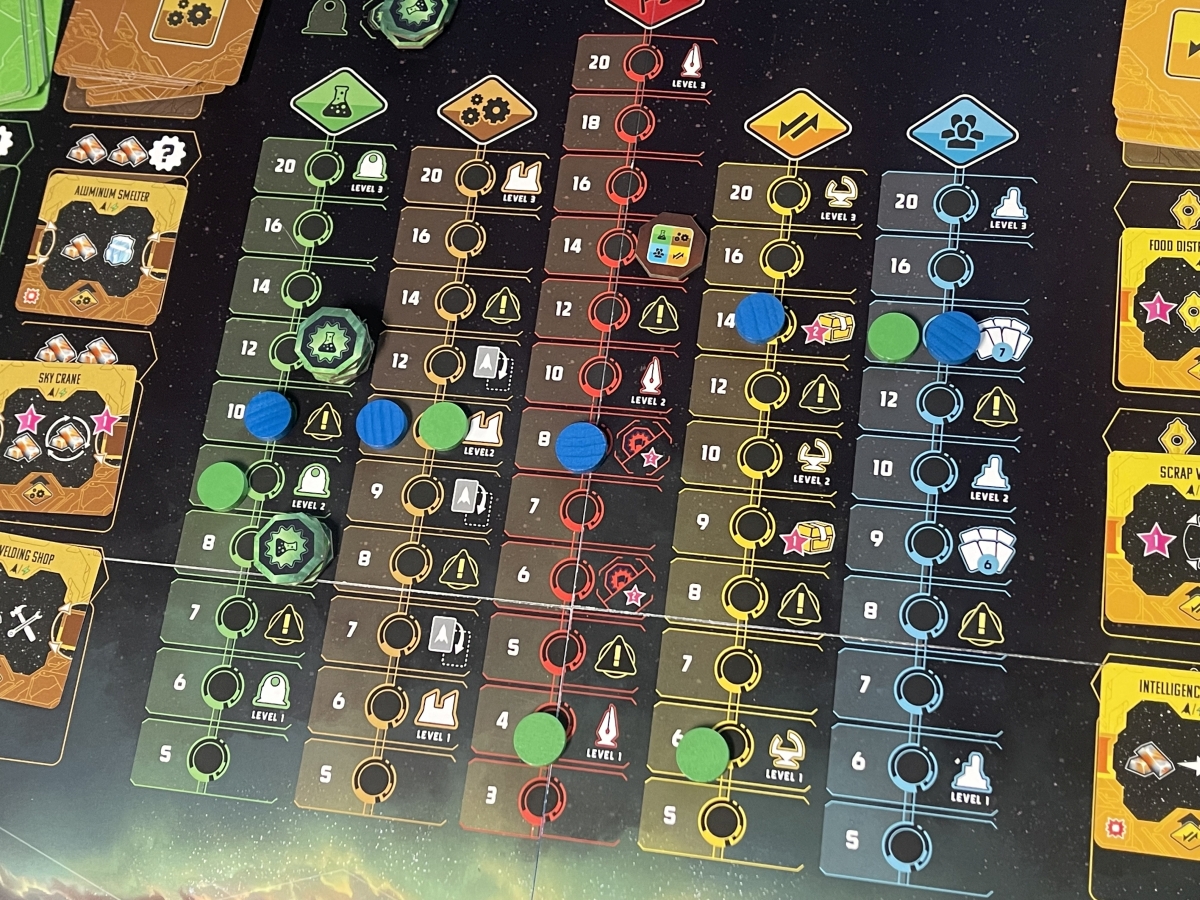
Progress Track Benefits
Advancing on the Progress Tracks provides both immediate and endgame scoring benefits. Each one also provides different, unique benefits:
- Science Track. 2 spaces have stacks of Discovery tokens. When you reach those spaces, you may look through the stacks and secretly choose 1 token to keep and use either immediately or as a free action later.
- Industry Track. Several spaces on the track allows the player a free Starship upgrade. Choose one of your upgrades and slot it onto your Station Mat. If you do not yet have that type of Starship, you may also build one for no cost.
- Supremacy Track. If you are the first to reach one of the Supremacy tokens, you may take it and use it then or later as a free action.
- Commerce Track. The higher you proceed on this track, the more leftover resources are worth during endgame scoring.
- Civilization Track. You can increase the size of your maximum hand size, which begins at 5 cards.
Game End
The endgame is triggered when any player reaches or surpasses the space on the VP track chosen at the start of the game. The Event track is no longer used from this point onward, and each player (including the active player) gets one additional turn after the active player has finished their turn.
Final Scoring
- Tracks. Each player gains VP for the positions of their markers on the 5 Progress Tracks.
- Developments. Each player gains VP for their Developments depending on the position of their marker on the particular track corresponding to each Development.
- Damage. Players lose 2 VP for each damaged Module.
- Vault Bonus. Depending on the position on the Commerce Track, players will earn between 0-2 VP for each leftover resource, including Tactics cards.
- Civilization Modules. Each player gains rewards as indicated on their undamaged Civilization Modules.
- Leaders. Each player receives 1 VP for each Leader still on their Station Mat.
Whoever has the highest score wins. Tiebreakers are most Modules, and if there’s another tie, then most resources.

Why You Should Play Andromeda’s Edge
At the conclusion of one of my games of Andromeda’s Edge, a friend of mine commented that this was the best “quick” alternative to Twilight Imperium that he had ever played. Of course, quick is a relative term: We had still played for over 3 hours. But for those of you that have played Twilight Imperium before know, getting through a game of that is an all-day event.
This isn’t to say that Andromeda’s Edge plays like Twilight Imperium. Yes, both games are set in space, and both games have elements of what we call a 4X game: explore, expand, exploit, and exterminate. But if anything, Andromeda’s Edge plays more like a Luke Laurie predecessor game, Dwellings of Eldervale. And that’s a good thing.
Andromeda’s Edge and Dwellings of Eldervale: The Inevitable Comparison
Many, including myself, are calling Andromeda’s Edge the spiritual successor to Dwellings of Eldervale, another popular Luke Laurie game. I reviewed Dwellings in 2021, and awarded it with GeekDad Approved. Several of my fellow game reviewers around the Web have already given point-by-point comparisons between Andromeda’s Edge and Dwellings, so I see no need to reiterate information you can easily find via a Google search.
Andromeda’s Edge is definitely not just Dwellings of Eldervale with a space theme slapped on. While both games share the same DNA, Andromeda’s Edge represents an evolution in the game mechanics present in Dwellings. Building a strong engine and progressing on all the tracks is fundamental to a player’s success, and requires a lot of advance planning as well as adjusting to the changing state of the game.
As such, it is a much crunchier game than Dwellings of Eldervale, which unfortunately means it can also slow down a game when someone who is prone to A.P. (analysis paralysis) is faced with all the choices available to them. However, this issue is hardly exclusive to Andromeda’s Edge, as it will turn up in any game that has tough choices for players to make.
A lot of people will ask, “I already have Dwellings of Eldervale, should I back Andromeda’s Edge?” or, “Which of these two games should I get?” My response would be that you don’t necessarily have to choose between the two games, unless you are tight on money or shelf space. Although both Andromeda’s Edge and Dwellings of Eldervale are structurally similar, they do ultimately scratch a different itch. Andromeda’s Edge stands on its own as the heavier, more complex cousin to Dwellings of Eldervale.
Final Thoughts on Andromeda’s Edge
I’ve really enjoyed my time with Andromeda’s Edge. As opposed to the aforementioned Twilight Imperium, this game is faster and easier to both teach and play. But even though it’s quick to pick up on the gameplay, there is a lot going on in Andromeda’s Edge that you’ll need to keep track of. During one of my games, an Event card had a certain Raider, the Korrugan Smugglers, make its appearance on the Main Board. One of my opponents decided he wanted to defeat this Raider right away, and did so. Unfortunately, in his bloodlust, he had momentarily forgotten the special rule for the Korrugan Smugglers, which reduces the cost of resources for developing regions while it was on the board. He ended up proverbially shooting himself in the foot, as he wasn’t able to make a Development that turn as he’d originally hoped.
The asymmetry of the different factions really works to the players’ benefit. With just two unique player powers and one unique Starship upgrade per faction, there’s a nice bit of variety to keep gameplay fresh without too much additional information that could have been overwhelming. None of the powers are overly strong, either, but instead provide some nice thematic flavor to each faction and encourages different styles of gameplay. For example, one of the factions I played, the Pulsewar Refugees, actually gets rewarded for losing a battle.
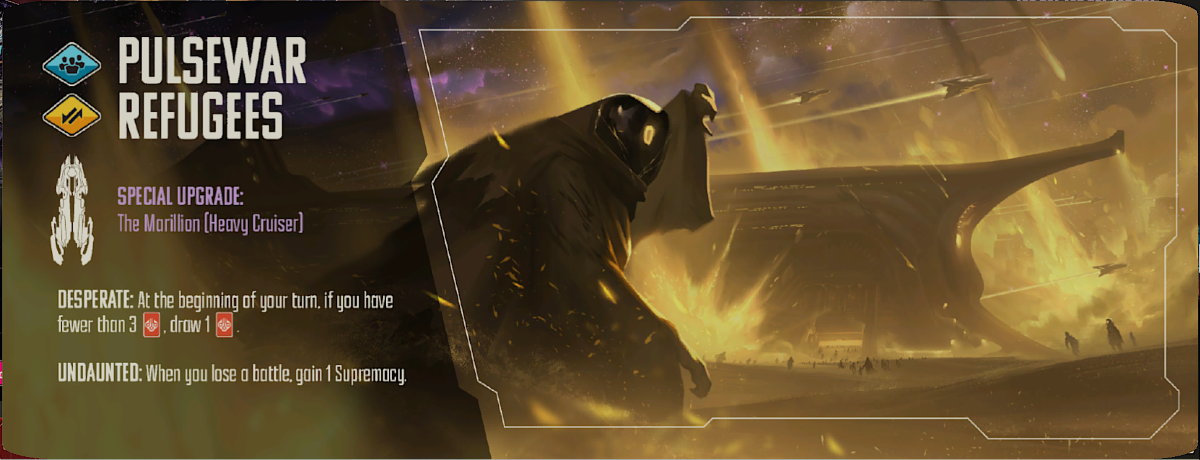
Much like in Dwellings of Eldervale, when you lose a battle, it’s a drawback but not overly punishing. You will also receive a reward, which is either to draw a new Tactics card, or to take whatever resource or benefit of a Moon that you have slotted into Tactical Operations. In one of my games, I had slotted in a Moon that gave me a card and 2 VP every time I lost a battle. So it’s no surprise for that game, I was looking into jumping into just about every battle I could!
The dice system of combat is refreshingly simple, and I really like the Targeting mechanic, which potentially allows you more re-rolls the more ships you have in the region. This is also a subtle (or not-so subtle) suggestion for players to commit more ships to a battle.
The use of Tactics cards can definitely be a game changer for battles. I had moved my heavy cruiser into one region where an opponent had just one of his transport ships, and during the escalation phase he moved in four other, powerful ships. But before we could fight, he played a card that allowed him to leave the battle, and gain victory points by doing so.

The Gamefound campaign offers two different versions of the game: a standard version and a deluxe (the all-in pledge is the deluxe version with add-ons). You can see all the differences on the Andromeda’s Edge campaign page, but essentially the deluxe version adds a single-player mode called UNITY, a fifth player, more miniatures, and custom-designed Game Trayz. The Game Trayz help to not just organize the components, but get the game to the table faster. The deluxe Edition is intended to be exclusive to Cardboard Alchemy crowdfunding and direct sales, so will not be available at retail stores.
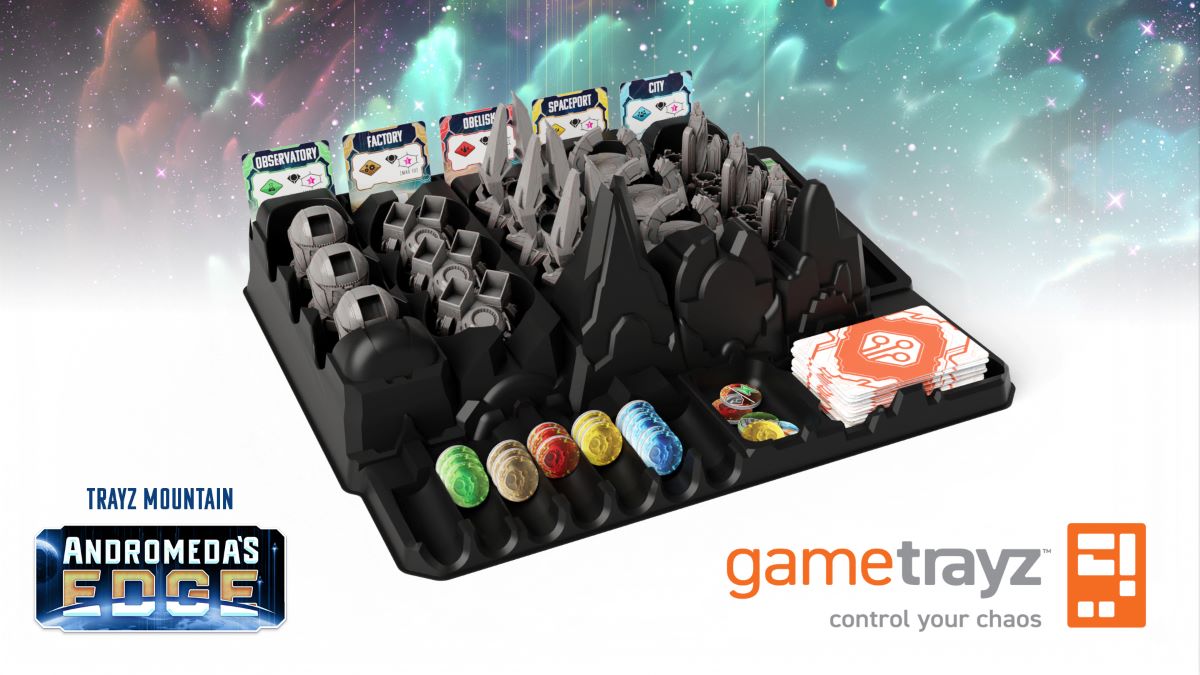
Andromeda’s Edge is a thoroughly enjoyable game that provides players with a wealth of strategic choices towards how to pursue victory. The downside to all those choices is that an experienced player will likely have an edge over first-time players. But because of the ease in learning the game, newer players should be able to readily catch up to more experienced ones in subsequent plays.
It’s a big game, and will likely be the only one you’ll play on a game night. But Andromeda’s Edge will be a fun, rewarding experience for players. I know I’ll be anxiously awaiting Andromeda’s Edge to ship, as I anticipate it making a regular appearance on my game table.
For more information or to make a pledge, visit the Andromeda’s Edge Gamefound page!

Click here to see all our tabletop game reviews.
![]() To subscribe to GeekDad’s tabletop gaming coverage, please copy this link and add it to your RSS reader.
To subscribe to GeekDad’s tabletop gaming coverage, please copy this link and add it to your RSS reader.
Disclosure: GeekDad received a copy of this game for review purposes.
